BY ROBERT ABELE
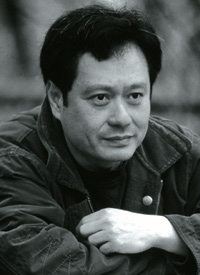 By 2000, Taiwanese filmmaker Ang Lee’s track record with sharply observed character studies was well-established, from the Taipei world of father and daughters in Eat Drink Man Woman to the disaffected American bourgeoisie of The Ice Storm. The big question then was what would an Ang Lee martial arts film look like?
By 2000, Taiwanese filmmaker Ang Lee’s track record with sharply observed character studies was well-established, from the Taipei world of father and daughters in Eat Drink Man Woman to the disaffected American bourgeoisie of The Ice Storm. The big question then was what would an Ang Lee martial arts film look like?
The answer in Crouching Tiger, Hidden Dragon was a psychologically rich and exhilarating period tale of repressed middle-aged romance, rebellious youth and eye-popping confrontations.
Working closely with storied Hong Kong action choreographer Yuen Wo Ping, Lee, who grew up a fan of swordplay epics, threw himself into the unique rigors of martial arts moviemaking. The climactic fight he describes here among the three main characters is one of the genre’s most emotional and cinematically beautiful sequences.
Starting in a roofless courtyard in the Anhui province of China, the scene features fierce combat between Michelle Yeoh’s battle-hardened Yu Shu Lien and Zhang Ziyi’s fiery aristocrat’s daughter Jen Yu, who wields the awesome (and stolen) sword Green Destiny. It segues into a tonally different face-off atop a lush, swaying bamboo forest between Jen and master warrior Li Mu Bai, played by Chow Yun Fat.
Seven years later, Lee still gushes about the flinty, spontaneous wisdom of fight maven Yuen. Ultimately, though, the director sought something more than mere flipping, kicking and clashing. “I didn’t allow them to do all the fantastic things they wanted to do. I still care for drama, character development through action, and aesthetics. What I did was stretch the genre.”
In a standard Chinese martial arts movie, the hard-core fighting is four minutes. That’s the goal I was aiming for. First Michelle Yeoh’s character tells all the servants to leave and close the door; she’s going to give [Zhang Ziyi’s character] a lesson. Because the martial arts film has more to do with Peking opera, they need to do a pose to signal to the audience that here comes the four minutes. This is very standard. They don’t just go up and fight. And the pose tells you what clan they came from. It’s a conversation with body language. This was a set we built in the Beijing studio.
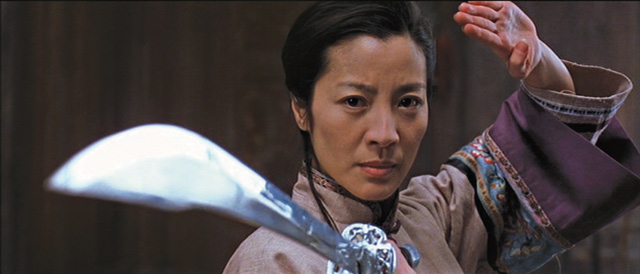
From the 1990s on, directors like to use a dolly in these kinds of shots to emphasize the weapon. You also emphasize the intensity of the facial expressions, eyes particularly. I dolly in to Michelle because she is the intense one. Also, Michelle is holding a knife, so the other hand is mimicking the knife posture. And if you go to the opposite shot, which is Zhang Ziyi’s pose, she has a sword and two fingers pointing. We used a Tibetan big horn and a ‘Grrrr’ sound effect, a tigress sound. I found that amusing.
This is the official start of the action. I use a medium-full shot, so you can see action and have space to see the weapons moving around. A shot this size is difficult for actors. A closer shot, they can do a little bit and it feels like a lot, but full body, they’ve got to be really good. Also Zhang is going to do a leap kick, so that needs wirework. She’s in a harness, and they cut holes in her clothes and attached the wires to the ceiling. That was digitally removed later.
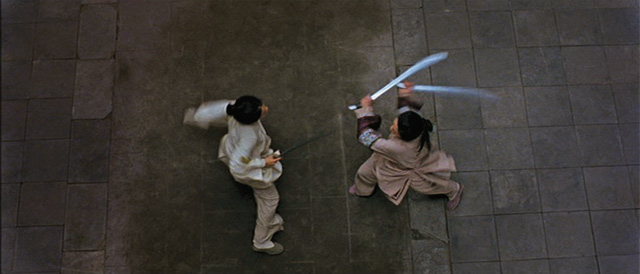
For me, this is an aesthetic choice, the detachment to an overhead. These are beautiful shots. Here the actors are having a conversation using their body language, as opposed to the closer shots where you see the excitement of weapons banging and facial expressions. Intermittently we detach to a top shot, and that makes you aware of the gracefulness. Also, there’s a chance to use stunt people. It’s a woman on the right, a man in a wig on the left. Usually martial arts movies aren’t looking for the aesthetic shot. When you have Jet Li, you don’t want to move the camera, you want to stay on his face.
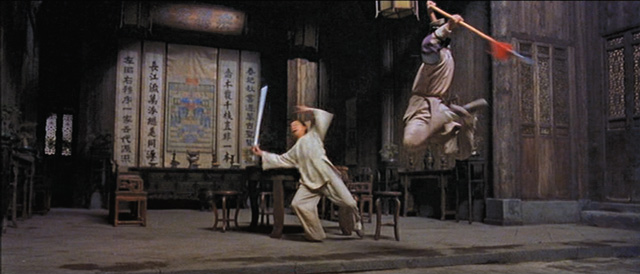
You have to use props after awhile in fighting to make the action exciting. So you see that great table? You have to smash it. We had only one, so it was a one-take deal. They cut it to pieces and had 12 guys pulling it with a string and it flies apart. The man on the left is one of the major doubles for Jet Li, and here he does three flips with a wire. And the other guy, that’s a real jump. You can see how good he is at arching his back. He has a slender body, so he doubles for women a lot.
Most of the sparks are real. They put some kind of electric gear and wire on both weapons so when they bang them, sparks come out. They wouldn’t allow that in the States. That close to actors? Probably not, let alone movie stars. The blue tinge you see is real. I think a couple shots were enhanced to make them more exciting in post.
Because I’m doing a more dramatic piece than the usual martial art film, there’s more intercutting between faces. You don’t want to continue the fight for four minutes. You’ve got to have them stop, bicker a little bit, pose, breathe, stare, go at it again, and escalate the fight. It has its own narration. I wanted to use a soft whip like a chain here, but Yuen Wo Ping said it would be very hard to accomplish anything with it, so his idea was that Michelle just go get a bigger sword. I thought that was funny.
Li Mu Bai shows up, and because he and Michelle’s characters are always preaching to her, Jen runs away. If I shot from the top, it would be about her action, so I shot from behind her, because she’s escaping. The sky was a replacement, because this was on a stage. The wires hang from the ceiling, and she flies about two stories high when they pull her up.
There’s an expression in flying technique about dragonflies, because they barely touch the water and then fly away. I wanted to see that literally happen. So we painstakingly structured poles on both sides of this pond and had 20 to 30 people pulling Chow Yun Fat and Zhang Ziyi so they can dip. Some crewmembers barfed from running so hard. And sometimes the actors ended up in the water instead of barely touching it. So eventually we corrected it in post with a computer. But they’re not digital. It’s not like Spider-man.
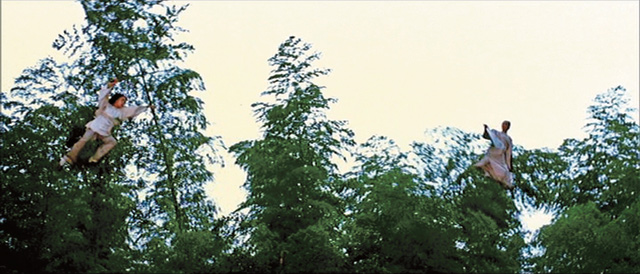
This is totally low tech. The actors are quite high, about 60 feet above the ground, and each of them is working off a big construction crane. They’re being pulled by 20 to 30 people from different directions, because they have to imitate the swinging nature of the bamboo. This shot was very difficult, because they have to fight a little bit, and mimic that lightness from underneath. I was worried; If the crane slipped, that would be very bad. I relied on Yuen Wo Ping. If he says it’s difficult, I would insist on doing it. If he says it’s dangerous, I would stop.
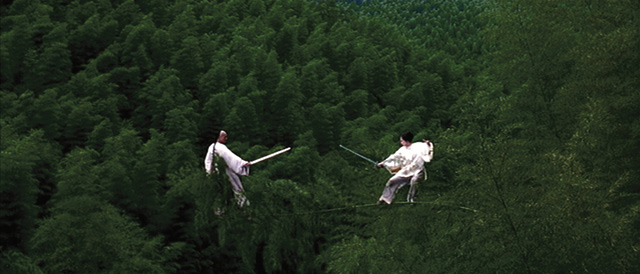
We shot from a two-story-high platform in a province about three and a half hours west of Shanghai. It’s very difficult to find a bamboo forest that has a road. Usually there’s no road to park a huge, 80-foot-high crane. Zhang has to keep stomping on that bamboo to try to shake him off, and she kept slipping. But if she is too stable, it looks like she’s pretending to stand on it instead of balancing on a branch. That bamboo they’re on is still attached. We bent it and staged it to look like that.
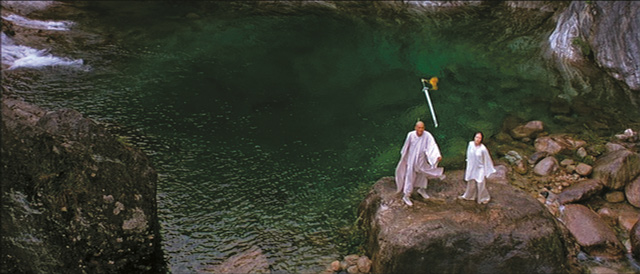
We shot at Huangshan, the Yellow Mountain, one of the premier mountains in China. It’s very beautiful. Green was my motif: the sword Green Destiny, the green bamboo, and the murky green is the source of mysterious femininity that Chow is looking for. It’s also danger. So we’re on a road looking down on that green pond so I can see the water, and it took up most of the negative space. And the martial arts crew invented something quite brilliant: To throw the sword the way I wanted it to go—blade first—they put some iron weight on the tip of the sword.
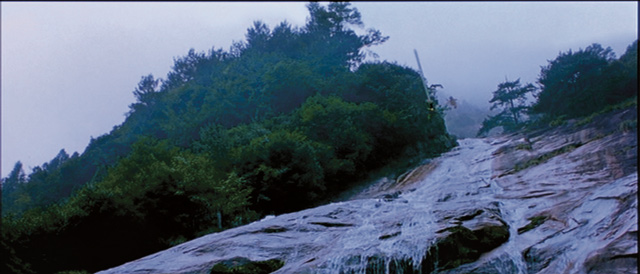
The sword and Zhang fly down, and they’re superimposed. We shot the elements, the sword and the people. We actually flew her down from 80 feet above, but not in this location. It was on a crane, and it was quite scary. Almost head down, just her and wirework. Back then the Chinese martial art film could still fight Hollywood action pictures because real people were doing it. When you don’t rely on a computer image, there’s a human connection. You believe people are doing that. With computers, I think psychologically you sit back and enjoy it, instead of sitting on the edge of your seat and worrying.
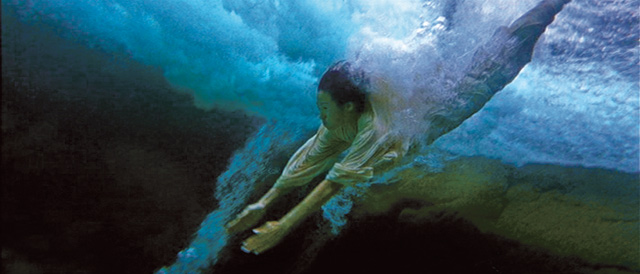
This was underneath the real falls. The sword preceding Zhang was pulled with underwater wirework. The sword goes where you want it to go, straight down, and it looks really cool. Zhang had to do diving, and she has a very light body, but I couldn’t have her go way up and dive. But she could never really sink, so we put two big pieces of camera weights on her back so she could sink. If we could manage it on screen, we didn’t do it in post. It’s really low tech. I think that’s the pinnacle of guerrilla filmmaking. It’s made up on the spot.